Creating your ultimate surround-sound system has never been easier with these stereo and spatial audio speakers.
Sonos has a stronghold on the home audio space. And, boy, does it have range—catering to industry pros; amateur audiophiles; and people who just like sleek speakers, plain and simple. The kingpin of the brand’s success is its usability. Its product line comprises a fleet of interconnected speakers that allow users to create a smart ecosystem in their home that plays well with different music streaming platforms and voice assistants. Moreover, the speakers are blissfully intuitive: press to play and pause; swipe across to skip or play back. To sweeten the deal, Sonos just launched two new additions: Era 100 and Era 300, available for pre-order today and shipping March 28.
We’ve made huge strides from mono audio.
“Eighty-five of the Billboard top 100 tracks released in Dolby Atmos to create more immersive sound—to feel music in the third dimension,” says Patrick Spence, CEO of Sonos. “We can’t use an existing approach to speakers to deliver true potential.”
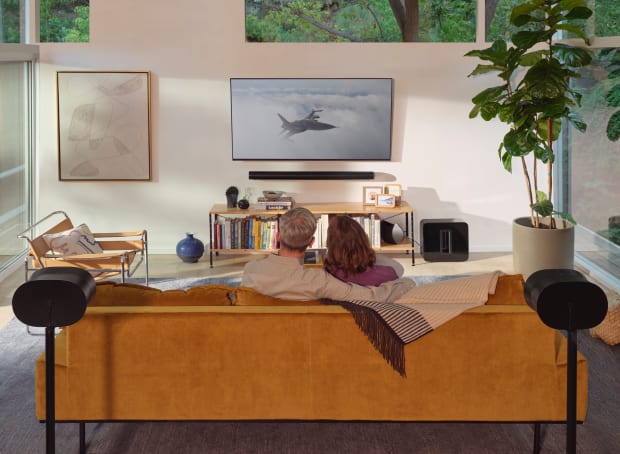
What Dolby Atmos Is and How It’s Evolving the Sound Experience
For the uninitiated, Dolby Atmos is surround-sound technology that adds height channels to existing systems, letting sound swell and unfurl in a more pure sense. The audio format reimagines sound as three-dimensional, not bound to spatial limitations.
“It’s not gimmicky like 3D TV,” says Giles Martin, sound experience leader at Sonos and son of legendary Beatles producer, George Martin. “We listen in 3D.”
Dolby Atmos is an elevated soundscape that lets artists and mixed engineers capture music as it was intended to be heard. Songs have more nuance and can be experienced with greater clarity and subtlety. Listening in Dolby Atmos is the closest thing you can get to nabbing a seat in the recording studio with an artist—letting yourself get swallowed whole by a sonic supernova.
Sonos' goal for innovation was to make its already great speakers more musical but without deception.
“Our ethos is honesty,” says Ryan Moore, who leads product management for Sonos’ Plun-In category. “We’re not trying to color sound.”
The goal was to capture sound that’s more airy and crisp, and get more bass that extends at higher volumes.
Engineers and product leads at Sonos also turned to the community, tapping industry titans like Grammy-winning mixed engineer Tom Elmhirst and Chris Jenkins to identify weak points, then return with feedback on new protos, asking: Is the sound honest?
The challenge with Sonos One, the brand’s hero product, is it’s a mono unit, meaning it only sends one signal to all speakers. So, even if you have a home entertainment system to create surround sound, there won’t be any variance. In short: It just gets louder.
That’s where Era 100 and Era 300 come in. Here’s the difference between Sonos’ newest product drops.
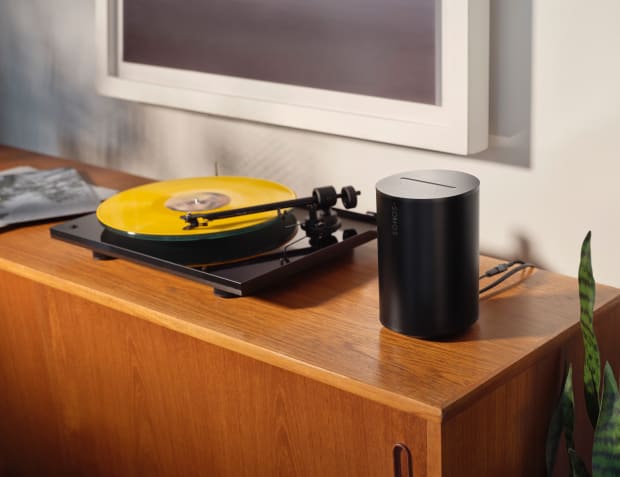
Sonos Era 100
This is a remaster of Sonos One. Maintaining the small form factor was key when designing it, which meant everything inside had to be reconsidered. Aesthetically, the speaker is more rounded than its predecessor, but the top surface interface still lets users tap and slide to control. Available colorways are black and white, but you’ll notice the white’s a little softer and warmer, not as stark. That’s partly a design move—to blend more seamlessly with home decor—but it’s also a sustainable one. It’s practically impossible to get true white from reclaimed materials. PCR plastic, a type of recycled plastic that’s reprocessed into a resin, produces a subtle white.
It’s part of Sonos’ responsible-design efforts. The brand is relying less on virgin plastic and using up to 45 percent recycled materials across its products, promoting better energy efficiency, and boosting repairability by replacing adhesives with screws so they can take the speaker apart and repair an element.
Sonos Era 100 boasts stereo separation, thanks to its acoustic architecture. Inside, there are two angled tweeters, a 25 percent larger midwoofer to deepen bass and power, and custom waveguides that disperse and direct sound waves to create a wider soundstage. This lets you pinpoint the location of instruments when listening to music.
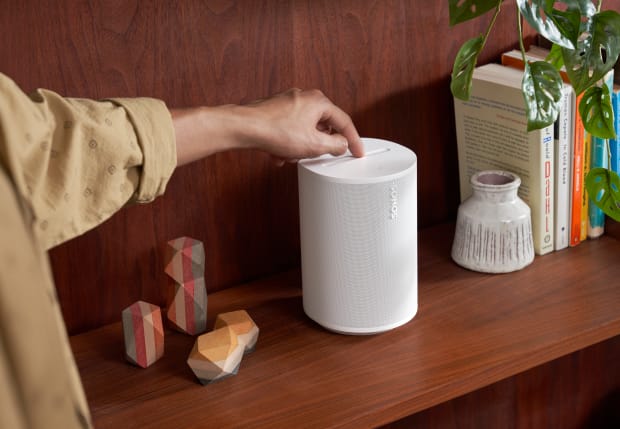
In lockdown Paul McCartney made an album that Martin mixed. He played the track “Deep Deep Feeling” to showcase how you can identify the drums are left and right, and McCartney is front and center. “It’s like a projector,” Martin says. “It’s not fragmented. It sounds honest and real, like he’s in the room. This brings you closer to the artist to feel like you’re at a concert.”
One of the most requested features from consumers was Trueplay™ for Android (not just iOS). This tuning technology measures your room’s unique acoustics to provide data points, then recalibrates the speaker’s EQ so the audio sounds as it should.
In addition to offering WiFi and Bluetooth connectivity, you can connect a turntable (or other audio source) to Era 100 with an auxiliary cable and the Sonos Line-In Adapter (sold separately).
Sonos Era 100 is targeted at consumers who want a to bring stereo sound to life at home, but don’t want to eat up too much real estate. At 7.18” tall, 4.72” wide, and 5.14” deep this fits perfectly on media consoles, bookshelves, dressers, and the like.
[Available March 28, $249; sonos.com]
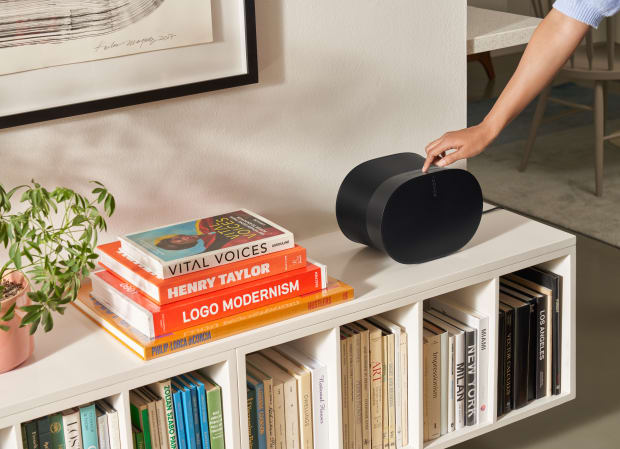
Sonos Era 300
For those seeking multi-channel surround sound, Sonos Era 300 is a room-filling wonder. The first thing you’ll notice is its unique shape.
“Era 300 is a completely new approach to sound and shape,” says Dana Krieger, VP of Design, Hardware at Sonos. “The calm design aesthetic is built around the acoustic architecture.”
It has six drivers, two woofers angled left and right to support stereo playback, and four tweeters. Wave guides are placed higher up on the speaker than before; its positioning in the middle shoots vocals and instrumentals out the front. And that distinct tapering in the center of the speaker lets Sonos position an upfiring tweeter, loaded in a directional cone, to reflect sound off the ceiling when playing Dolby Atmos content.
“We’ve got distinct left, right, forward, and upward projection for accuracy, getting to the heart of music as it was intended to be heard,” says Moore.
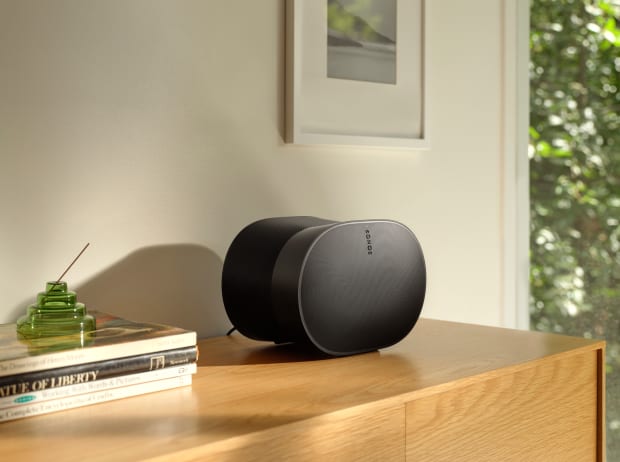
When combined with a Sonos Arc or Beam (Gen 2), it blows out the cinema experience. As far as music goes, mixed engineers allege it was the first time hearing tracks back correctly on a commercial speaker. High-reverb tracks, like Post Malone’s “Cooped Up” are punchy and clear but not at the sacrifice of bass. And you can really sense the height in a track like “Sharks” from Imagine Dragons; it blooms.
Remember what we said about responsible design? Sonos Era 300 is held together by 93 screws. It’s a painstaking process to build and repair, but this allows Sonos to replace only the parts that need it without scrapping a speaker entirely. The packaging has also gone eco-friendly, with a rattan handle and recycled materials.
Sonos Era 300 is targeted to consumers who want an immersive home theater or the ability to turn their living room into a bona fide concert venue (stands and wall mounts sold separately). Bonus: Sonos is adding support for spatial audio on Apple Music starting March 28, which will be available on Sonos Era 300, as well as Arc and Beam (Gen 2). Its size is not obtrusive but has a larger profile at 6.30” tall, 10.24” wide, and 7.28” deep.
[Available March 28, $449; sonos.com]
from Men's Journal https://ift.tt/Qs6p47k


0 comments